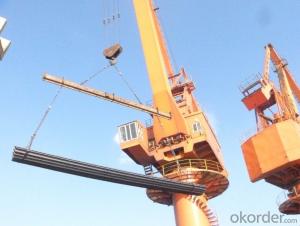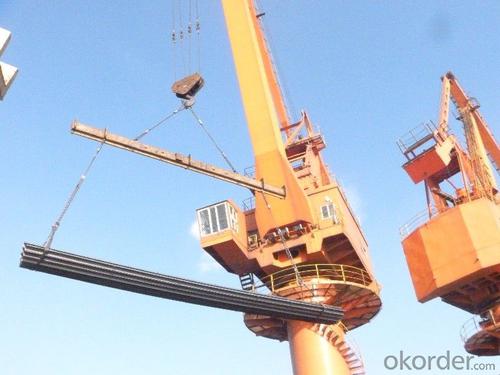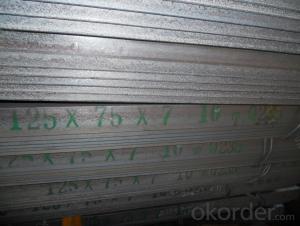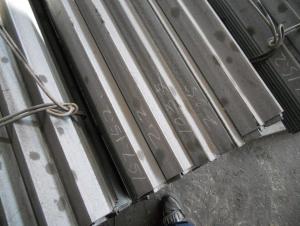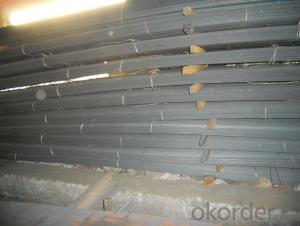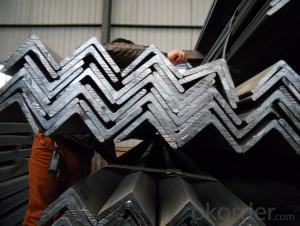Hot Rolled Equal Angle Steel with Many Sizes
- Loading Port:
- Tianjin
- Payment Terms:
- TT or LC
- Min Order Qty:
- 20 m.t.
- Supply Capability:
- 1000 m.t./month
OKorder Service Pledge
OKorder Financial Service
You Might Also Like
Product Description:
OKorder is offering Hot Rolled Carbon Steel Equal Angle at great prices with worldwide shipping. Our supplier is a world-class manufacturer of steel, with our products utilized the world over. OKorder annually supplies products to European, North American and Asian markets. We provide quotations within 24 hours of receiving an inquiry and guarantee competitive prices.
Product Applications:
According to the needs of different structures, Angle can compose to different force support component, and also can be the connections between components. It is widely used in various building structures and engineering structures such as roof beams, bridges, transmission towers, hoisting machinery and transport machinery, ships, industrial furnaces, reaction tower, container frame and warehouse etc.
Product Advantages:
OKorder's Equal Angle are durable, strong, and resist corrosion.
Main Product Features:
· Premium quality
· Prompt delivery & seaworthy packing (30 days after receiving deposit)
· Corrosion resistance
· Can be recycled and reused
· Mill test certification
· Professional Service
· Competitive pricing
Product Specifications:
1. Invoicing on theoretical weight or actual weight as customer request
2. Length: 6m, 9m, 12m as following table
3. Sizes
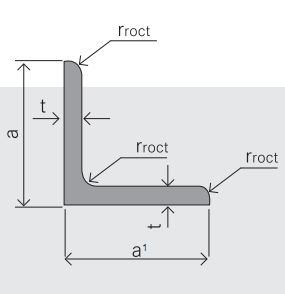
Sizes: 25mm-250mm | ||
a*t | ||
25*2.5-4.0 | 70*6.0-9.0 | 130*9.0-15 |
30*2.5-6.6 | 75*6.0-9.0 | 140*10-14 |
36*3.0-5.0 | 80*5.0-10 | 150*10-20 |
38*2.3-6.0 | 90*7.0-10 | 160*10-16 |
40*3.0-5.0 | 100*6.0-12 | 175*12-15 |
45*4.0-6.0 | 110*8.0-10 | 180*12-18 |
50*4.0-6.0 | 120*6.0-15 | 200*14-25 |
60*4.0-8.0 | 125*8.0-14 | 250*25 |
4. Payment terms:
1).100% irrevocable L/C at sight.
2).30% T/T prepaid and the balance against the copy of B/L.
3).30% T/T prepaid and the balance against L/C
5.Material details:
Alloy No | Grade | Element (%) | |||||
C | Mn | S | P | Si | |||
Q235 | B | 0.12—0.20 | 0.3—0.7 | ≤0.045 | ≤0.045 | ≤0.3 | |
Alloy No | Grade | Yielding strength point( Mpa) | |||||
Thickness (mm) | |||||||
≤16 | >16--40 | >40--60 | >60--100 | ||||
≥ | |||||||
Q235 | B | 235 | 225 | 215 | 205 | ||
Alloy No | Grade | Tensile strength (Mpa) | Elongation after fracture (%) | ||||
Thickness (mm) | |||||||
≤16 | >16--40 | >40--60 | >60--100 | ||||
≥ | |||||||
Q235 | B | 375--500 | 26 | 25 | 24 | 23 | |
FAQ:
Q1: Why buy Materials & Equipment from OKorder.com?
A1: All products offered byOKorder.com are carefully selected from China's most reliable manufacturing enterprises. Through its ISO certifications, OKorder.com adheres to the highest standards and a commitment to supply chain safety and customer satisfaction.
Q2: How do we guarantee the quality of our products?
A2: We have established an advanced quality management system which conducts strict quality tests at every step, from raw materials to the final product. At the same time, we provide extensive follow-up service assurances as required.
Q3: How soon can we receive the product after purchase?
A3: Within three days of placing an order, we will begin production. The specific shipping date is dependent upon international and government factors, but is typically 7 to 10 workdays.
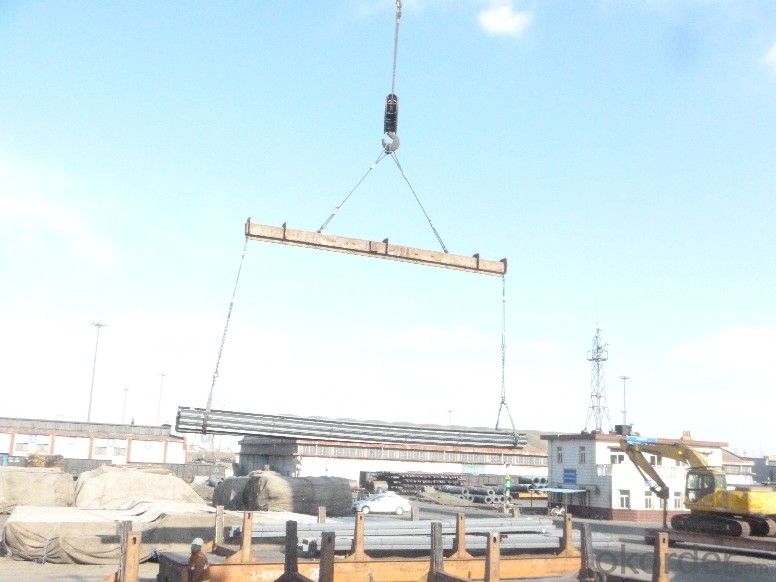

- Q: Are steel angles affected by vibration?
- Vibration can indeed impact steel angles. When exposed to consistent or repetitive vibrations, steel angles may experience fatigue or stress cracking over time. This occurs because vibrations, particularly those with high frequency or amplitude, can induce dynamic loads on the steel angles. These loads can result in cyclic stresses and strains, ultimately causing damage to the material. In certain instances, excessive vibrations can even lead the steel angles to resonate, resulting in amplified oscillations that can lead to structural failure. It is important to acknowledge that the vulnerability of steel angles to vibrations is influenced by various factors, including the steel's quality and strength, the magnitude and frequency of vibrations, and the structure's design and installation. To mitigate the effects of vibration on steel angles, engineers and designers often utilize diverse techniques. These may include implementing damping systems, employing vibration isolation methods, or reinforcing the structure to enhance its resistance to dynamic loads. Regular inspections and maintenance are also vital to detect and address any potential issues caused by vibrations. By doing so, the structural integrity and durability of steel angles can be ensured.
- Q: Can steel angles be used in high-rise buildings?
- High-rise buildings can indeed utilize steel angles. These angles are frequently employed as structural elements in such structures, owing to their strength, adaptability, and cost-effectiveness. They find application in a variety of ways, including framing, bracing, and load support. By offering stability and structural integrity, steel angles enable high-rise buildings to withstand the forces and strains typically associated with such edifices. Moreover, their easy fabrication, manipulation, and connection make them well-suited for the intricate and elaborate designs often seen in high-rise constructions. Consequently, steel angles serve as a dependable and commonly used constituent in the construction of high-rise buildings.
- Q: What is the bending capacity of a steel angle?
- The ability of a steel angle to withstand bending or flexing without breaking or deforming excessively is known as its bending capacity. This capacity reflects the angle's structural strength and is typically influenced by factors such as the angle's dimensions, thickness, type of steel, and presence of any additional reinforcements or supports. To determine the bending capacity, it is common to express it as the maximum load or stress that the angle can endure before it permanently deforms at its yield point. The bending capacity of a steel angle can vary significantly based on these factors, and it is of utmost importance to consider this capacity during the design and construction of structures that incorporate steel angles to ensure their structural integrity and safety.
- Q: How are steel angles tested for quality and strength?
- Steel angles are tested for quality and strength through various methods to ensure they meet the required standards and specifications. One of the primary tests conducted on steel angles is the tensile test, which measures the material's resistance to breaking under tension. This test involves applying a gradually increasing load to a sample of the steel angle until it reaches its breaking point. The maximum load the angle can withstand is measured, and this provides critical information about its tensile strength. Another important test is the hardness test, which determines the steel angle's resistance to indentation. This test helps to assess the material's ability to withstand wear and tear, as well as its overall strength. Hardness is typically measured using the Rockwell or Brinell scales, where a harder material indicates higher strength. To ensure the steel angle's quality, it also undergoes visual inspections for any surface defects, such as cracks, uneven surfaces, or deformities. These inspections are conducted by trained professionals who carefully examine the angles for any imperfections that may compromise their structural integrity. In addition to these tests, steel angles may also undergo chemical composition analysis to verify that the material meets the required specifications. This analysis determines the percentage of various elements present in the steel, such as carbon, manganese, and sulfur, which directly impact the angle's strength and durability. Overall, steel angles are rigorously tested for quality and strength through a combination of physical, visual, and chemical tests. These tests ensure that the angles can withstand the intended loads and perform safely in various applications, providing confidence in their reliability and longevity.
- Q: How do steel angles compare to other structural shapes like beams and channels?
- Steel angles, beams, and channels are all common structural shapes used in construction. While beams and channels are primarily used to carry loads in horizontal applications, steel angles are versatile and can be used in both horizontal and vertical applications. Unlike beams and channels, steel angles have two legs that form a 90-degree angle, providing greater stability and resistance to bending. Additionally, steel angles are often more cost-effective than beams and channels due to their simpler design. However, the choice between steel angles, beams, and channels ultimately depends on the specific requirements of the project and the loads they need to support.
- Q: What are the different types of connections used for steel angles in marine applications?
- In marine applications, steel angles are commonly used to provide structural support and reinforcement. These angles are connected using various types of connections to ensure their stability and strength in the harsh marine environment. Some of the different types of connections used for steel angles in marine applications include: 1. Welded Connections: Welding is one of the most common methods used to connect steel angles in marine applications. It involves joining the angles by melting the base metals and then allowing them to cool and solidify. Welded connections provide excellent strength and durability, making them suitable for heavy-duty marine applications. 2. Bolted Connections: Bolted connections are another commonly used method for connecting steel angles in marine applications. This involves using bolts, nuts, and washers to secure the angles together. Bolted connections offer ease of installation and allow for disassembly if required. They are also suitable for situations where the angles need to be adjusted or replaced. 3. Riveted Connections: Riveting is an older method of connecting steel angles that is still used in some marine applications. It involves using a rivet—a metal pin with a head on one end—to connect the angles. The rivet is inserted through pre-drilled holes in the angles and then deformed to secure them together. Riveted connections offer good strength and resistance to vibration, but they can be more time-consuming to install compared to other methods. 4. Adhesive Connections: Adhesive bonding is a modern method used for connecting steel angles in marine applications. It involves using high-strength adhesives to join the angles together. Adhesive connections offer the advantage of distributing stress evenly across the connected surfaces and eliminating the need for drilling or welding. However, they may require careful surface preparation and curing time to achieve optimal strength. 5. Hybrid Connections: In some cases, a combination of different connection methods may be used for steel angles in marine applications. For example, a welded-bolted connection may be employed to provide additional strength and redundancy. Hybrid connections offer the benefits of multiple connection methods while ensuring a robust and reliable connection. The choice of connection type for steel angles in marine applications depends on various factors such as the load requirements, environmental conditions, and project specifications. It is essential to consider the specific needs of the application and consult with structural engineers and marine professionals to determine the most suitable connection method.
- Q: Can steel angles be used in the construction of storage tanks?
- Steel angles have the potential to be utilized in the construction of storage tanks. These angles are frequently employed in the construction sector due to their robustness, longevity, and adaptability. When it comes to storage tanks, steel angles can serve as structural elements to provide the necessary support and stability for the tank's framework. They are commonly employed to establish the framework for the tank's walls, roof, and base, thereby ensuring the overall strength and stability of the tank. Furthermore, steel angles can also be used to reinforce corners and joints, thereby enhancing the structural integrity of the tank. In general, incorporating steel angles into the construction of storage tanks is a dependable and cost-efficient option.
- Q: What do you mean by "corner steel plate pull knot"?
- The specifications are expressed in millimeters of edge width * edge width * edge thickness. Such as "30 x 30 x 3", that is 30 mm width equal angle, edge thickness of 3 mm. Also available models that model is the number of centimeters wide, such as 3#. The model does not mean the size of the different edges and sizes of the same model. Therefore, the width, the edge and the thickness of the angle iron should be filled out in the contract and other documents, so as not to be indicated by the model alone. Standard Specification for hot-rolled equal angle iron is 2#-20#.
- Q: How do steel angles contribute to architectural design?
- Architectural design relies heavily on steel angles due to their ability to offer both structural stability and design flexibility. These angled steel profiles are commonly utilized in various construction projects, including buildings, bridges, and other structures, to provide support and reinforcement. A significant advantage of steel angles in architectural design lies in their capacity to enhance the structural integrity of a building. By creating rigid connections between different structural elements, these angles add strength and stability to the overall structure, enabling it to withstand different loads and forces. This is especially crucial in high-rise buildings or structures situated in areas prone to earthquakes or strong winds. Furthermore, steel angles empower architects and designers to create distinctive and innovative architectural features. Their versatility allows for the development of aesthetically pleasing designs, such as cantilevered balconies, intricate facades, and unique rooflines. Due to their ability to be easily manipulated and welded, steel angles are well-suited for complex geometric shapes and creative design concepts. Moreover, steel angles offer cost-effective solutions in architectural design. They are readily available in various sizes and lengths, making them easily obtainable and integratable into construction projects. Their durability and low-maintenance properties make them a long-lasting and economical choice for architects, reducing the need for frequent repairs or replacements. Additionally, steel angles contribute to sustainability in architectural design. Steel is a highly recyclable material, and incorporating steel angles into construction projects reduces the demand for new materials. Additionally, the lightweight nature of steel angles allows for efficient transportation, reducing carbon emissions during the construction process. In conclusion, steel angles are indispensable in modern architectural design due to their ability to provide structural support, design flexibility, cost-effectiveness, and sustainability. Their usage not only enhances the overall strength and stability of a structure but also enables architects to create visually appealing and unique designs. With their numerous benefits, steel angles have become an integral element in contemporary architectural design.
- Q: Can steel angles be used in bridges?
- Yes, steel angles can be used in bridges. Steel angles are often used as structural elements in bridge construction due to their strength, versatility, and ability to provide support and stability. They can be used in various bridge components such as beams, trusses, and connections, helping to distribute loads and resist forces in bridge structures.
Send your message to us
Hot Rolled Equal Angle Steel with Many Sizes
- Loading Port:
- Tianjin
- Payment Terms:
- TT or LC
- Min Order Qty:
- 20 m.t.
- Supply Capability:
- 1000 m.t./month
OKorder Service Pledge
OKorder Financial Service
Similar products
Hot products
Hot Searches
Related keywords
